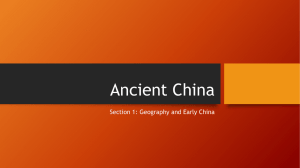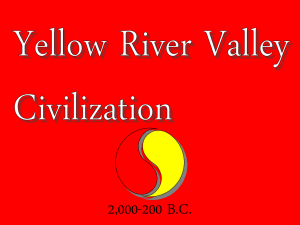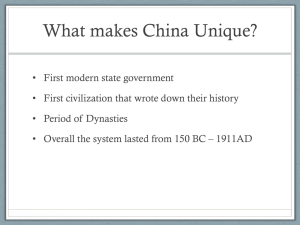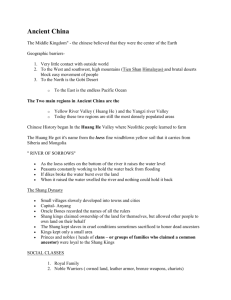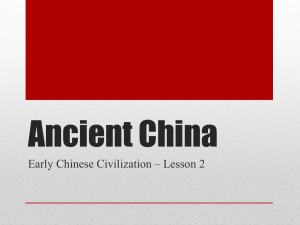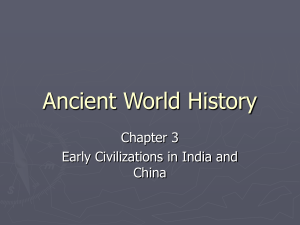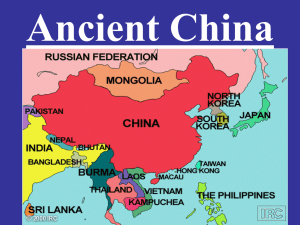River Valley Civilizations - Pascack Valley Regional School District
advertisement
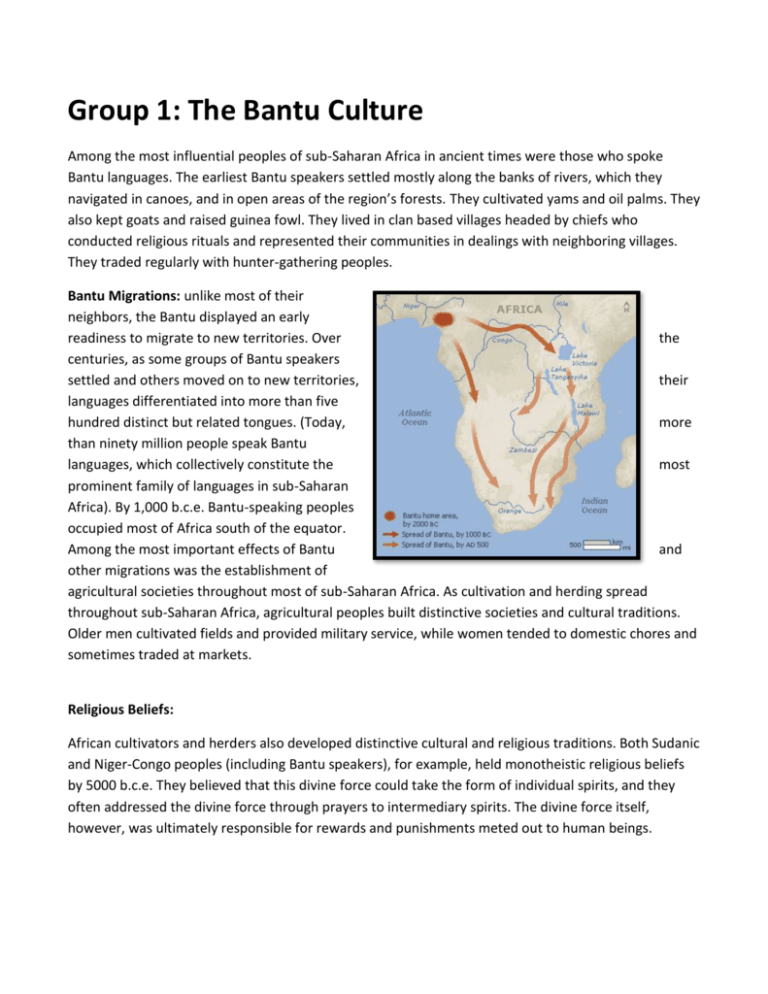
Group 1: The Bantu Culture Among the most influential peoples of sub-Saharan Africa in ancient times were those who spoke Bantu languages. The earliest Bantu speakers settled mostly along the banks of rivers, which they navigated in canoes, and in open areas of the region’s forests. They cultivated yams and oil palms. They also kept goats and raised guinea fowl. They lived in clan based villages headed by chiefs who conducted religious rituals and represented their communities in dealings with neighboring villages. They traded regularly with hunter-gathering peoples. Bantu Migrations: unlike most of their neighbors, the Bantu displayed an early readiness to migrate to new territories. Over the centuries, as some groups of Bantu speakers settled and others moved on to new territories, their languages differentiated into more than five hundred distinct but related tongues. (Today, more than ninety million people speak Bantu languages, which collectively constitute the most prominent family of languages in sub-Saharan Africa). By 1,000 b.c.e. Bantu-speaking peoples occupied most of Africa south of the equator. Among the most important effects of Bantu and other migrations was the establishment of agricultural societies throughout most of sub-Saharan Africa. As cultivation and herding spread throughout sub-Saharan Africa, agricultural peoples built distinctive societies and cultural traditions. Older men cultivated fields and provided military service, while women tended to domestic chores and sometimes traded at markets. Religious Beliefs: African cultivators and herders also developed distinctive cultural and religious traditions. Both Sudanic and Niger-Congo peoples (including Bantu speakers), for example, held monotheistic religious beliefs by 5000 b.c.e. They believed that this divine force could take the form of individual spirits, and they often addressed the divine force through prayers to intermediary spirits. The divine force itself, however, was ultimately responsible for rewards and punishments meted out to human beings. The Indus Valley: Like early agricultural societies in Mesopotamia and Egypt, Harappan society—named after Harappa, one of its two chief cities—developed in the valley of a river, the Indus, whose waters were available for irrigation of crops. By 3000 b.c.e. Neolithic villages were evolving into thriving cities. Many Harappan remains are not accessible because the water level has been raised over the centuries, placing many remains under water. Also, the written language is difficult to decipher because there are over 400 symbols in the language. The Indus draws its waters from rain and melting snow in towering mountains (the Hindu Kush and Himalayas). Like the Nile, the Indus deposits rich soil as it courses through lowlands and loses its force. Today a series of dams has largely tamed the Indus, but for most of history it spilled its waters annually over a vast floodplain, sometimes with devastating effect. The Indus made agricultural society possible in northern India. The most important food crops and domesticated animals came to the region from Mesopotamia. As in Mesopotamia and Egypt, agricultural surpluses in India vastly increased the food supply, stimulated population growth, and supported the establishment of cities and specialized labor. The agricultural surplus of the Indus valley fed tow large cities, Harappa and Mohenjo-daro. Harappan society embraced much of modern day Pakistan and northern India. It was considerably larger than Mesopotamia and Egypt. Harrappan Society: Archeological excavation ahs turned up no evidence of royal or imperial authority in Harappan culture. Both Harappa and Mohenjo-daro (Md) had city walls, a fortified citadel, and a large granary, suggesting that they served as centers of political authority and sites for the collection and redistribution of taxes paid in the form of grain. Both cities had marketplaces, temples, public buildings, extensive residential districts, and broad streets. Specialized Labor: Like all complex societies in ancient times, Harappa depended on a successful agricultural economy. But Harappans also engaged in trade, both domestic and foreign. From neighboring peoples in Persia and the Hindu Kush Mountains, the Harappans obtained gold, silver, copper, lead, gems and semiprecious stones. During the period about 2300 to 1750 b.c.e. they also traded with Mesopotamians, exchanging Indian copper, ivory, beads, and semiprecious stones for Sumerian wool, leather, and olive oil. Most trade was probably traveled by ships that followed the coastline of the Arabian Sea between the mouth of the Indus River and Persian Gulf. Social Distinctions: The wealth of Harappan society, like that in Mesopotamia and Egypt, encouraged the formation of social distinctions. The Harappans built no pyramids, palaces, or magnificent tombs, but their rulers wielded great authority from the citadels at Harappa and Md. It is clear from Harappan dwellings that rich and poor lived different styles. Most Indus valley inhabitants were farmers. Well Planned Cities Reveal Organized Government: a notable feature of Md and a few smaller sites is how carefully planned they were. Md was laid out in an organized pattern, with, long, wide main streets and large rectangular blocks. Most if its houses were built with baked clay bricks of a standard size. At Harappa and other Indus sites, mud and unbaked bricks were also common building materials. In addition, Indus houses had complex plumbing systems, with baths, drains and water chutes that led into sewers beneath the streets. Fertility Cults: Harappan religion reflected a strong concern for fertility. Harappans venerated gods and goddesses whom they associated with creation and procreation. Fertility and procreation are prominent concerns in popular Hinduism, and scholars have often noticed similarities between Harappan and Hindu deities associated with those values (continuity!). Harappan Decline: Sometime after 1900 b.c.e. Harappan society entered a period of decline. One theory holds that ecological degradation was a major cause of decline. Harappans deforested the Indus valley to clear land for cultivation and to obtain firewood. Deforestation led to erosion of topsoil and also to reduced amounts of rainfall. This caused the area to be mostly a desert (of course it took hundreds of years). It is also possible that natural catastrophes—floods, earthquakes—weakened Harappan society. Many Harappan traditions were taken in by other cultures and therefore lived well beyond the end of the Harappan society. By 1500 b,c,e, the civilization crumbled with the arrival of the Aryans. The Arrival of the Aryans: The Aryans were nomadic tribes from north of the Caucasus Mountains. Using horses and advanced weaponry, they easily defeated the populations in the Indus Valley. Each of the Aryan tribes migrated to India independently; over a period of time, they began to settle in the Indus Valley, where they would give up their nomadic lifestyles. The important thing to remember about the Aryan conquest of the Indus Valley is the establishment of their religious beliefs on the Indian subcontinent, in particular their belief in reincarnation. The Aryans, yet another polytheistic people, recorded their beliefs and traditions in the Vedas and the Upanishads. Over centuries, these early Aryan beliefs evolved to form the basis for what later became Hinduism. The Aryan, social structure also had a major impact on later developments in India. Combined with Hinduism, it formed the basis of what later became the caste system. Initially, the Aryan social structure divided its people into three classes, in this order from top to bottom: warriors, priests, and peasants. Later, a class of landowners and merchants would be added above the peasant class; and the priest class (known as Brahmans) would be moved above the warrior class because they were considered closer to the gods. In the early days of this system, movement between classes as allowed. But as the system became more complex and ingrained in society, it became more rigid. Eventually, subcastes were added to the four main castes, and social mobilit y among the castes was prohibited. Because members of different castes could not marry, children were born into the same castes as their parents, and stayed there. Ancient China Like the Indus, the Yellow River is boisterous and unpredictable. It rises in the mountains bordering het high plateau of Tibet, and it courses almost 2,920 miles. It gets its name from the vast quantities of light-colored loess soil (a sediment/silt) that it picks up along the route. The river enabled the development of a complex civilization and the fertile soil assisted in its growth. Chinese legends speak of three ancient dynasties—the Xia, the Shang, and the Zhou. They were regional dynasties that would later be replaced by later Chinese dynasties that embraced all the territory. Xia: Most likely the dynasty came into being about 2200 b.c.e. by extending formal control over a region, the Xia dynasty established a precedent for hereditary monarchial rule in China. Supposedly it was the dynasty’s founder who organized effective flood-control projects. Thus here, as in Mesopotamia and Egypt, the need to organize large-scale public works projects helped to establish recognized authorities and formal political institutions. From the Shang to the Zhou Dynasty: Growing south of the Xia dynasty was the Shang dynasty. Tradition assigns the Shang dynasty to the period 1766 to 1122 b.c.e. because the Shang dynasty left written records as well as material remains, the basic features of early Chinese society come into much clearer focus than they did during the Xia. As in other civilizations, the top level of Shang society included the royal family and a class of noble warriors. Shang warriors used leather armor, bronze weapons, and horse-drawn chariots. They might have learned of chariots from the Asian peoples with whom they interacted. A majority of Shang Chinese people were peasants. They clustered in farming villages. Peasants led grueling lives. By 1122 b.c.e. the Xhou people overthrew the Shang. They established the Zhou dynasty which lasted until 256 b.c.e. There was also a sizable class of slaves, most of whom were enemy warriors captured during battles. Mandate of Heaven: The Mandate of Heaven is the divine right to rule. The cruelty of the last Shang king, they declared, had so outraged the gods that they had sent ruin on him. The gods then passed the Mandate o f Heaven to the Zhou.The Chinese later expanded the idea of the Mandate of Heaven to explain the dynastic cycle, or the rise and fall of dynasties. As long as the dynasty provided good government, it enjoyed the Mandate of Heaven. If the rulers became weak or corrupt, the Chinese believed that heaven would withdraw its support. Establishing a Feudal State: the Zhou rewarded their supporters by granting them control over different regions. Thus, under the Zhou, China developed into a feudal state. Feudalism was a system of government in which local lords governed their own lands but owed military service and other forms of support to the ruler. Eventually, fighting and warfare among the feudal kingdoms brought an end to the Zhou Dynasty in 256 b.c.e. Also, technological developments acted in the favor of subordinate rulers. The Shang kings had largely monopolized the production of bronze weapons by controlling the sources of copper and tin, but because of technological changes, Zhou rulers were unable to control metal production as closely as their predecessors. The rampant production of iron got into the hands of subordinates and helped them to rebel against the Zhou dynasty. Social Order: Already during the Xia dynasty, but especially under the Shang and Zhou, the royal family and allied noble families occupied the most honored positions in Chinese society. Specialized Labor: A small class of free artisans and craftsmen plied their trades in eth cities of ancient China. Some, who worked almost exclusively for the privileged classes, enjoyed a reasonably comfortable existence. Jewelers, jade workers, embroiderers, and manufacturers of silk textiles also benefited socially because of their importance to the ruling elites. Merchants and Trade: long distance trade routes reached China during Shang and Xia times as well. Despite high mountain ranges and deserts that stood between China and complex societies in India and southwest Asia, trade networks linked China with lands to the west and south early in the third millennium b.c.e. Jade in Shang tombs came from central Asia, and military technology involving horse drawn chariots came through central Asia from Mesopotamia. Shang bronzesmiths worked with tin that came from the Malay peninsula in southeast Asia. Archeologists have unearthed a few pieces fo Shang pottery from Md and other Harappan sites. Accounts credit King Yu, founder of the Xia dynasty, with the invention of sails. During the Zhou dynasty, shipbuilding emerged as a prominent business all along coastal china, and mariners had discovered how to navigate their vessels by the stars and other heavenly bodies. Patriarchal Society: Chinese society vested authority principally in elderly males who headed their households. Chinese society was strongly patriarchal. During the Shang and Zhou dynasties, women lived increasingly in the shadow of men. Large states brought the military and political contributions of men into sharp focus. The emphasis on men became an intense characteristic of Chinese society—after the Shang dynasty. Not even queens and empresses merited temples dedicated exclusively to their memories. Ancestral Veneration In the absence of organized religion or official priesthood in ancient China, the patriarchal head of the family presided at rites and ceremonies honoring ancestors’ spirits. Therefore, the family patriarch possessed tremendous authority. There was no organized religion in ancient China (change from other river valley civilizations). Oracle Bones In Mesopotamia and India, merchants pioneered writing. In China, the earliest known writing served the interests of rulers rather than traders. One medium for writing was oracle bones. Oracle bones were used by fortune-tellers in ancient China. They were specially prepared bones (turtle shells, bones of sheep) to inscribe questions. The bones would be subjected to heat at which point they would crack. Fortune tellers then studied the patterns and determined answers Mesoamerica Societies didn’t build on river valleys! By 8000 to 7000 b.c.e the peoples of Mesoamerica—the region from the central portion of modern Mexico to Honduras and El Salvador— had begun toe experiment with the cultivation o squashes, manioc, beans, chili peppers, avocados, and gourds. By 4000 b.c.e. they had discovered the agricultural potential of maize, which soon became the staple crop of the region. Most large animals in the western hemisphere were not susceptible to domestication. So Mesoamericans were unable to harness the energy of animals such as horses and oxen that were prominent in the eastern hemisphere. Of the 14 major domestic animals, only one is in the western hemisphere (the llama/alpaca). It was primarily in the Andes. Human laborers prepared fields for cultivation, and human porters carried trade goods on their packs. They had no need for wheeled vehicles, which would have been useful only if animals were available to pull them. The Olmecs: the “Rubber People: Agricultural villages and ceremonial centers arose in several regions of Mesoamerica. The name of the early peoples, Olmecs, derives from the rubber trees tha t flourished in the region that they inhabited. Olmec society was probably authoritarian in nature. Untold thousands of laborers participated in the construction of the ceremonial centers of the major cities. Each of the principal Olmec sites featured an elaborate complex of temples, pyramids, alters, stone sculptures and tombs for rulers. Common subjects labored regularly on behalf of the Olmec elite—not only in the building of drainage systems and ceremonial centers but also in providing appropriate artistic adornment for the capitals. The most distinctive artistic creation was the colossal heads. Trade in Jade and Obsidian: Olmecs spread their influence through military force. The Olmecs produced large numbers of decorative objects from jade, which they had to import. In the absence of any metal technology, they also made extensive use of obsidian from which they fashioned knives and axes with wickedly sharp cutting edges. The decline of the Olmec society is a mystery. They might have destroyed their own ceremonial centers (filled with pyramids) in San Lorenzo and La Venta (of course modern names) because of civil conflicts or doubts about the effectiveness and legitimacy of the ruling classes. Nevertheless, Olmec traditions deeply influenced later Mesoamerican societies. Olmecs made astronomical observations and created a calendar to help them keep track of the seasons. They invented a system of writing although unfortunately little of it survives beyond calendrical inscriptions. They also carried out rituals involving human sacrifice and invented a distinctive ball game. The Maya: The earliest heirs of the Olmecs were the Maya, who created a remarkable society in the region now occupied by southern Mexico, Guatemala, Belize, Honduras and El Salvador. The Mayan civilization was similar to many other civilizations at that time in that it was a collection of city-states; however, all the city-states were ruled by the same king. Interestingly, like the Egyptians, the Maya were pyramidbuilders, and also wrote using hieroglyphics. The golden age of the Mayan Civilization was from about 500 to about 850 c.e. During that time, the Maya produced many great works of scholarship and developed a complex calendar system but we know the most about its architecture and city planning because many remains have been discovered. No question, the Maya built tremendous cities—Tikal, the most important Mayan political center, may have been population by more than 100,000 people. Similar to most agricultural societies, the majority of people were peasants or slaves. Kings, priests, and hereditary nobility were at the top of the social pyramid. Merchants also enjoyed a high status. The Maya used advanced agricultural techniques, such as the ridged field system, to make them most of the rainfall and swamp conditions of the region. Cotton and maize were widely cultivated; the Maya are known for their elaborate cotton textiles. Many well-preserved ruins of the civilization remain today, including the tiered temps at Chichen Itza, which is similar in design to the Egyptian pyramids and Mesopotamian ziggurats. Significantly, the Mayan calendar, based on a number system that include zero, was among the most accurate for its time. They invented zero! They derived the knowledge of the calendar from the Olmec predecessors. Maya Society and Religion Apart from kings and ruling families, Maya society included a large class of priests who maintained an elaborate calendar and transmitted knowledge of writing, astronomy and mathematics. Surviving inscriptions and other writings shed considerable light on Maya religious and cultural traditions. The Popol Vuh, a Maya creation myth, taught that the gods had created human beings out of maize and water, the ingredients that became human flesh and blood. Thus Maya religious thought reflected the fundamental role of agriculture in their society, much like religious thought in early complex societies of the early complex societies. Maya priests also taught that the gods kept the world going and maintained the agricultural cycle in exchange for honors and sacrifices performed for them by human beings. The most important of htose sacrifices involved the shedding of human blood. In ball games (athletics) losers often lost their heads as a sacrifice to the gods. Thus, blood shedding extended to the realm of sports. The City of Teotihuacan Teotihuacan flourished north of the Mayan culture. Apart from rulers and priests, Teotihuacan’s population included cultivators, artisans, and merchants. Perhaps as many as two-thirds of the city’s inhabitants worked the fields. Until about 500 c.e There was little sign of military organization in Teotihuacan. The Teotihuacan residents built on the foundations of the Olmecs. They played the ball game and extended the Olmec’s writing style. Works of art suggest that they recognized an earth god and a rain god, and it is certain that they carried out human sacrifices during their rituals. The city declined by the eight century due to invaders who sacked and burned the city putting the city into ruin. South America: The heartland of Andean society developed in Peru and Bolivia. Most of the early Andean heartland came under cultivation between 2500 and 2000 b.c.e. and permanent settlements dotted the coastal regions in particular. They cultivated beans, peanuts and sweet potatoes as their main crops. The most important domesticated animal was the llama. This provided meat and wool as well as transportation in some areas (transport of goods).They also cultivated cotton. The Chavin culture developed in the Andes from 900 to 300 b.c.e. the Chavin were another urban civilization, and their people were also polytheistic. They had access to a coast and were agricultural. The Chavin developed ways to use metals in tools and weapons. Oceania Human migrants entered Australia and New Guinea at least by 60,000 years before the resent, and possibly earlier than that. They arrived in watercraft—probably rafts, or perhaps canoes fitted with sails—but because of the low sea levels of that era, the migrants did not have to cross large stretches of open ocean. The earliest inhabitants were hunter-gatherers. The aboriginal Australians lived in small, mobile communities that undertook seasonal migrations in search of food. The earliest inhabitants of New Guinea foraged for food, like their neighbors in the south. About five thousand years ago, however, a process of social and economic change began to unfold in New Guinea. Change came from the Austronesian speaking people peoples (Indonesian, Filipino, Polynesian and other Oceanic languages). They sailed the open ocean in large canoes equipped with outriggers, which stabilized their craft for long voyages. Austronesians depended on cultivation of root crops and herding animals. When they settled in New Guinea, they introduced yams, taro, pigs, and chickens to the island, and the indigenous peoples themselves soon began to cultivate crops and keep animals. Agriculture took off. This brought population growth a nd specialization of labor: after the change to agriculture, permanent settlements, pottery, and carefully crafted tools appeared throughout the island. Map of Austronesian migrations

